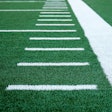Understanding fixture capabilities can lead to substantial water savings in athletics, fitness and recreation facilities.
Home to showers, toilets, urinals and faucets, locker rooms represent huge consumers of potable water within athletics, fitness and recreation facilities. By taking the following steps, facility operators can realize utility savings, while also helping reduce the energy consumption that water treatment demands.
Consider stormwater reclamation systems.
Although such systems require a separate cistern and filtration, stormwater can be reclaimed for nonpotable uses such as flushing. Keep in mind that some jurisdictions require nonpotable water to be marked with food-grade dye as undrinkable before it can be introduced to a facility.
Replace older-model toilets.
Many facilities still feature 3.5 gallons-per-flush toilets, which was for years the industry standard. Low-flow 1.6 and 1.26 GPF models are now widely available and have proven effective at removing waste. Don't use 3.5 GPF flush valves in lower-flow toilets, or the water savings could be lost.
Upgrade urinals.
Most urinals are 1 GPF models, a result of standards set in the Energy Policy Act of 1992. Considering urinals are used far more frequently than toilets in men's locker rooms and bathrooms, replacing 1 GPF models with 0.5 GPF or pint-per-flush models can provide immediate water savings. Waterless urinals - which utilize a trap cartridge that works with a liquid sealant that rises to the top of the urine and prevents odor emissions - also are widely available.
Retrofit sink faucet aerators.
Many faucets are 2.5 gallons-per-minute models, but retrofitted aerators can dramatically reduce the flow while maintaining pressure, allowing for a thorough hand-washing. The replacement can be done for as little as $1 per faucet. When specifying new fixtures, choose low-flow (1 or even 0.5 GPM) models.




































